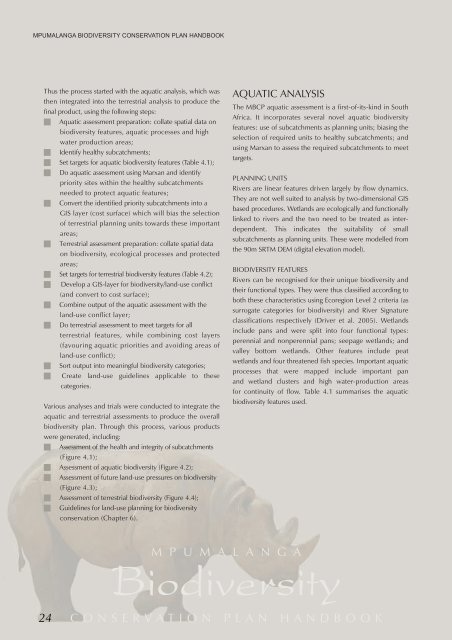Mpumalanga Biodiversity Conservation Plan Handbook - bgis-sanbi
Mpumalanga Biodiversity Conservation Plan Handbook - bgis-sanbi
Mpumalanga Biodiversity Conservation Plan Handbook - bgis-sanbi
Create successful ePaper yourself
Turn your PDF publications into a flip-book with our unique Google optimized e-Paper software.
MPUMALANGA BIODIVERSITY CONSERVATION PLAN HANDBOOK<br />
Thus the process started with the aquatic analysis, which was<br />
then integrated into the terrestrial analysis to produce the<br />
final product, using the following steps:<br />
Aquatic assessment preparation: collate spatial data on<br />
24<br />
biodiversity features, aquatic processes and high<br />
water production areas;<br />
Identify healthy subcatchments;<br />
Set targets for aquatic biodiversity features (Table 4.1);<br />
Do aquatic assessment using Marxan and identify<br />
priority sites within the healthy subcatchments<br />
needed to protect aquatic features;<br />
Convert the identified priority subcatchments into a<br />
GIS layer (cost surface) which will bias the selection<br />
of terrestrial planning units towards these important<br />
areas;<br />
Terrestrial assessment preparation: collate spatial data<br />
on biodiversity, ecological processes and protected<br />
areas;<br />
Set targets for terrestrial biodiversity features (Table 4.2);<br />
Develop a GIS-layer for biodiversity/land-use conflict<br />
(and convert to cost surface);<br />
Combine output of the aquatic assessment with the<br />
land-use conflict layer;<br />
Do terrestrial assessment to meet targets for all<br />
terrestrial features, while combining cost layers<br />
(favouring aquatic priorities and avoiding areas of<br />
land-use conflict);<br />
Sort output into meaningful biodiversity categories;<br />
Create land-use guidelines applicable to these<br />
categories.<br />
Various analyses and trials were conducted to integrate the<br />
aquatic and terrestrial assessments to produce the overall<br />
biodiversity plan. Through this process, various products<br />
were generated, including:<br />
Assessment of the health and integrity of subcatchments<br />
(Figure 4.1);<br />
Assessment of aquatic biodiversity (Figure 4.2);<br />
Assessment of future land-use pressures on biodiversity<br />
(Figure 4.3);<br />
Assessment of terrestrial biodiversity (Figure 4.4);<br />
Guidelines for land-use planning for biodiversity<br />
conservation (Chapter 6).<br />
AQUATIC ANALYSIS<br />
The MBCP aquatic assessment is a first-of-its-kind in South<br />
Africa. It incorporates several novel aquatic biodiversity<br />
features: use of subcatchments as planning units; biasing the<br />
selection of required units to healthy subcatchments; and<br />
using Marxan to assess the required subcatchments to meet<br />
targets.<br />
PLANNING UNITS<br />
Rivers are linear features driven largely by flow dynamics.<br />
They are not well suited to analysis by two-dimensional GIS<br />
based procedures. Wetlands are ecologically and functionally<br />
linked to rivers and the two need to be treated as interdependent.<br />
This indicates the suitability of small<br />
subcatchments as planning units. These were modelled from<br />
the 90m SRTM DEM (digital elevation model).<br />
BIODIVERSITY FEATURES<br />
Rivers can be recognised for their unique biodiversity and<br />
their functional types. They were thus classified according to<br />
both these characteristics using Ecoregion Level 2 criteria (as<br />
surrogate categories for biodiversity) and River Signature<br />
classifications respectively (Driver et al. 2005). Wetlands<br />
include pans and were split into four functional types:<br />
perennial and nonperennial pans; seepage wetlands; and<br />
valley bottom wetlands. Other features include peat<br />
wetlands and four threatened fish species. Important aquatic<br />
processes that were mapped include important pan<br />
and wetland clusters and high water-production areas<br />
for continuity of flow. Table 4.1 summarises the aquatic<br />
biodiversity features used.<br />
M P U M A L A N G A<br />
<strong>Biodiversity</strong><br />
CONSERVATION PLAN HANDBOOK

















